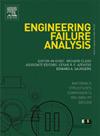Machine learning-assisted intelligent identification of hydrogen trap information in temperature-programmed hydrogen desorption
IF 5.7
2区 工程技术
Q1 ENGINEERING, MECHANICAL
引用次数: 0
Abstract
Green hydrogen is a clean energy with great development prospects. However, in hydrogen-rich environments, certain mechanical properties of metals can degrade significantly, potentially leading to serious structural failures in engineering applications. Among the many factors affecting the hydrogen embrittlement sensitivity of materials, the diffusion and capture behavior of hydrogen is particularly key. Thermal Desorption Spectroscopy (TDS) is one of the key technologies for studying these behaviors. However, identifying hydrogen trap information from TDS data remains a significant challenge. To address this issue, this study proposes a machine learning-based approach for the intelligent identification of hydrogen trap information, facilitating the rapid, accurate, and robust extraction of hydrogen trap density and binding energy from TDS, including both single-trap and distinct double-trap scenarios. In the proposed approach, an Oriani-based hydrogen transport equilibrium model was implemented in MATLAB to generate a large number of TDS data samples. A TDS fitting procedure based on the asymmetric double sigmoidal function is developed to represent the TDS data using five parameters. These five fitting parameters and the hydrogen trap characteristics are used as input features and output targets, respectively, to construct the machine learning models. Among four classical machine learning algorithms evaluated, the support vector machine exhibits the highest predictive accuracy. Furthermore, compared with widely used methods for hydrogen trap identification, the proposed approach demonstrates significant advantages in terms of accuracy, efficiency, and robustness. This research provides a powerful tool for gaining deeper insights into hydrogen behavior in metals.
温度程序化氢解吸中氢阱信息的机器学习辅助智能识别
绿色氢是一种极具发展前景的清洁能源。然而,在富氢环境中,金属的某些机械性能会显著下降,可能导致工程应用中严重的结构失效。在影响材料氢脆敏感性的诸多因素中,氢的扩散和俘获行为尤为关键。热解吸光谱(TDS)是研究这些行为的关键技术之一。然而,从TDS数据中识别氢阱信息仍然是一个重大挑战。为了解决这一问题,本研究提出了一种基于机器学习的氢阱信息智能识别方法,促进了从TDS中快速、准确、稳健地提取氢阱密度和结合能,包括单阱和不同的双阱场景。该方法在MATLAB中实现了基于oriani的氢输运平衡模型,生成了大量的TDS数据样本。提出了一种基于非对称双s型函数的TDS拟合方法,用5个参数表示TDS数据。将这5个拟合参数和氢阱特征分别作为输入特征和输出目标,构建机器学习模型。在评估的四种经典机器学习算法中,支持向量机的预测精度最高。此外,与广泛使用的氢阱识别方法相比,该方法在准确性、效率和鲁棒性方面具有显著优势。这项研究为深入了解氢在金属中的行为提供了有力的工具。
本文章由计算机程序翻译,如有差异,请以英文原文为准。
求助全文
约1分钟内获得全文
求助全文
来源期刊

Engineering Failure Analysis
工程技术-材料科学:表征与测试
CiteScore
7.70
自引率
20.00%
发文量
956
审稿时长
47 days
期刊介绍:
Engineering Failure Analysis publishes research papers describing the analysis of engineering failures and related studies.
Papers relating to the structure, properties and behaviour of engineering materials are encouraged, particularly those which also involve the detailed application of materials parameters to problems in engineering structures, components and design. In addition to the area of materials engineering, the interacting fields of mechanical, manufacturing, aeronautical, civil, chemical, corrosion and design engineering are considered relevant. Activity should be directed at analysing engineering failures and carrying out research to help reduce the incidences of failures and to extend the operating horizons of engineering materials.
Emphasis is placed on the mechanical properties of materials and their behaviour when influenced by structure, process and environment. Metallic, polymeric, ceramic and natural materials are all included and the application of these materials to real engineering situations should be emphasised. The use of a case-study based approach is also encouraged.
Engineering Failure Analysis provides essential reference material and critical feedback into the design process thereby contributing to the prevention of engineering failures in the future. All submissions will be subject to peer review from leading experts in the field.
 求助内容:
求助内容: 应助结果提醒方式:
应助结果提醒方式:


